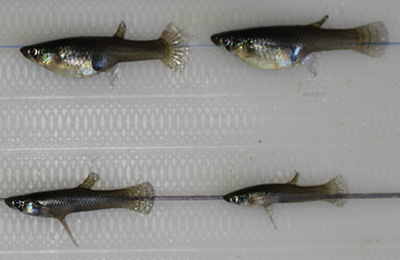Campus News
Mosquitofish populations with more females have greater ecological impact
Scientists investigating the ecological consequences of sexual dimorphism and sex ratio variation found dramatic effects



Female mosquitofish are not only bigger than the males, they have bigger impacts on freshwater ecosystems. In a controlled study conducted in experimental ponds, researchers found dramatic differences in pond ecosystems depending on the ratio of males to females in the mosquitofish populations. In ponds dominated by female fish, the researchers observed more pronounced ecological changes, including fewer zooplankton and a greater abundance of algae, than in male dominated ponds.
Mosquitofish, which are often used to control disease-spreading mosquitos, are probably the most widely introduced freshwater species in the world, according to Eric Palkovacs, assistant professor of ecology and evolutionary biology at UC Santa Cruz. They are also listed among the world’s 100 worst invasive species by the International Union for Conservation of Nature.
“Mosquitofish are known to have detrimental effects on native freshwater fauna, and in a lot of places there are efforts to control and extirpate them. It’s been called the ‘plague minnow’ in Australia and New Zealand because its effects are so drastic,” Palkovacs said.
Palkovacs and graduate student David Fryxell are senior author and first author, respectively, of a paper on the new findings published October 21 in Proceedings of the Royal Society B.
Trophic cascade
In addition to eating mosquito larvae, mosquitofish prey on other insect larvae, amphibian larvae, and zooplankton such as Daphnia, tiny crustaceans that graze on algae in freshwater ecosystems. Female mosquitofish prefer larger food items than males, have higher feeding rates, and spend more time foraging in the presence of other females. High levels of predation can ripple through the food web in what ecologists call a “trophic cascade.” When mosquitofish consume a lot of Daphnia, the resulting trophic cascade leads to an increase in algae.
“Daphnia are the principle grazers in freshwater ponds, keeping algal populations in check,” Palkovacs explained. “We found that female-dominated mosquitofish populations cause much more dramatic trophic cascades. When there are more males, the Daphnia population remains higher and algal abundance is lower.”
Other effects seen in female-dominated ponds included increased temperature and pH.
Palkovacs noted that many studies have looked at the evolutionary biology of sexual dimorphism (differences between the sexes in traits such as body size or coloring) and variations in sex ratios (when populations deviate from a one-to-one ratio of males to females). But little attention has been paid to the ecological consequences of these phenomena.
“When males and females of a species differ in traits like body size, they might use different resources or interact with the ecological community in different ways. As a result, the species can shape the ecosystem differently depending on the sex ratio of the population,” Palkovacs said.
Control strategies
Sex ratios in natural populations of mosquitofish vary considerably from place to place around the world. Furthermore, several of the methods used or proposed for use in controlling mosquitofish populations can lead to changes in the sex ratio. For example, trapping or netting selectively removes larger fish, so would principally target females. “In this case, removing more females than males is a good thing because females have the biggest effects on the ecosystem,” Palkovacs said.
Another strategy has been proposed that would involve genetically manipulating the fish so that females only produce male offspring. “The idea was to reduce the reproductive output of the population. Our research shows that this strategy could be doubly beneficial, leading to smaller populations in the long run while also creating more male-biased populations in the short run with less severe ecological impacts,” Palkovacs said.
Beyond its practical implications for mosquitofish management, the study highlights an important phenomenon that may be widespread in nature. “Sexual dimorphism is very common, as is sex ratio variation. It’s not just a mosquitofish phenomenon,” Palkovacs said.
To conduct the experiment, the researchers set up an array of large stock tanks on a level field at UCSC’s Long Marine Laboratory. They added sediment and plankton collected from a nearby pond to establish a small freshwater ecosystem in each tank. Mosquitofish were obtained from a California mosquito vector control district, sorted by sex, and introduced into the tanks at five different sex ratios, plus a fish-free reference treatment.
Bird netting kept out birds and mammals that might prey on the fish, but allowed naturally occurring insects and amphibians to lay eggs in the tanks. In the experiment, amphibians laid eggs in all of the treatments, but larval amphibians (tadpoles) were only found in tanks without mosquitofish.
The detrimental effects of mosquitofish on native biodiversity have been widely studied. Sex ratios may play an important role in this, although additional studies in natural settings will be needed to see what the effects of sex ratio variation are in the wild, “in the midst of all the other natural variation,” Palkovacs said.
In addition to Fryxell and Palkovacs, the coauthors of the paper include UCSC graduate student Travis Apgar and Heather Arnett and Michael Kinnison of the University of Maine. This work was funded by the National Science Foundation, UC Santa Cruz, and the Maine Agricultural and Forest Experiment Station.